
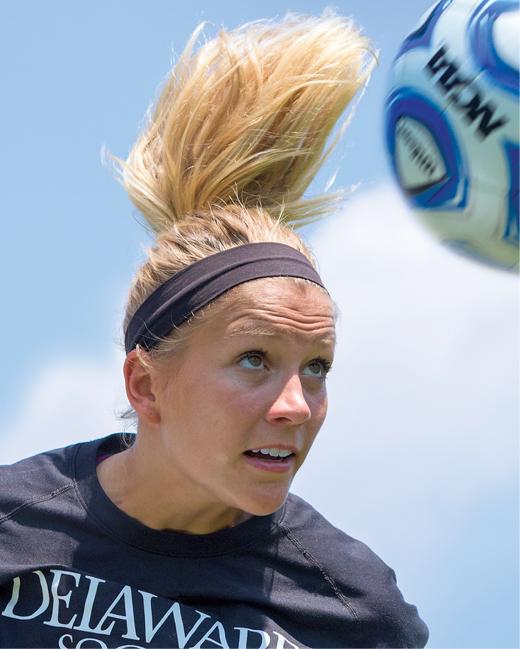
Head First
OUR UD | A concussion can happen in less than a quarter of a second, roughly the same amount of time it takes to Google the word. But despite 15 million hits on the search engine, there’s surprisingly scant information on the millions of hits that result in traumatic brain injuries every year.
A generation ago, athletes at all levels were expected to shake off a mild blow to the head and get back on the field. However, news of brain dysfunction and premature death in retired NFL players, including linebacker Junior Seau and safety Andre Waters, has recently brought the issue of sports-related head injury into the spotlight, where UD research is now taking a shining role.
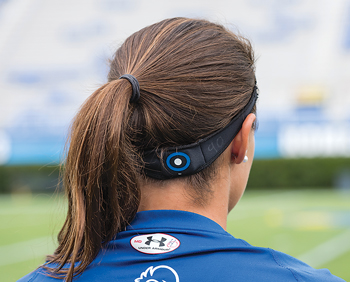
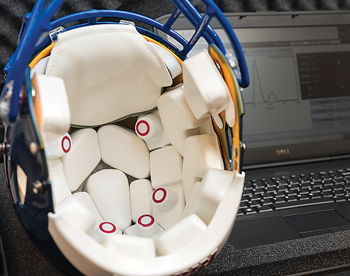
(Bottom) Battery-powered sensors on football helmets detect and record data on the magnitude, duration, location and direction of impacts to the head.
“A lot of people want to make hasty decisions about concussion prevention and treatment,” says Tom Kaminski, director of the athletic training education program and a professor of kinesiology and applied physiology at the University of Delaware. “But we need more data before we can make evidence-based recommendations to clinicians, coaches and legislators.”
Big data on the way
Kaminski is partnering with Triax Technologies, developers of SIM-G technology, to collect data on head impacts from the UD women’s soccer team via unobtrusive headbands outfitted with nickel-sized sensor packs. SIM is an acronym for Smart Impact Monitor, and the G refers to the G-force impact that is monitored with the company’s headbands and skullcaps.
Meanwhile, Kaminski’s colleague Tom Buckley, assistant professor of kinesiology and applied physiology, is tracking impacts to the head among UD football players using a software system known as HITS (Helmet Impact Telemetry System). HITS employs battery-powered sensors in helmet padding to detect the magnitude, duration, location and direction of impacts and sends this information to a computer that records the data.
Both professors are also involved in a landmark $23 million comprehensive study of concussion and head impact exposure on some 25,000 male and female NCAA student-athletes in all varsity sports at 21 schools, including more than 600 at UD.
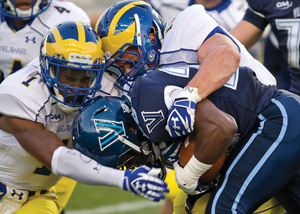
Funded by the NCAA and the U.S. Department of Defense, the research is aimed at establishing the natural history of concussion—including risks, treatment and management—so that more effective tools to predict and treat brain injuries can be developed.
For the three-year study, which began in September 2014, pre-season baseline tests are carried out to assess athletes’ balance and brain function. In addition, any athlete who experiences a concussion will undergo a series of five post-concussion screenings, beginning in the acute phase immediately after injury and concluding at the six-month point.
“Our hope is that the NCAA-DOD study will be the ‘Framingham Study’ of concussion,” says Buckley, referring to the 1948 study that identified risk factors for heart disease and remains a world-class resource for cutting-edge heart, brain, bone and sleep research. “The data collected in this study, combined with clinical data, will also enable advanced research to be conducted on brain injuries.”
Studying cause and effect
One of the challenges in addressing the concussion issue is defining what causes the injury in the first place. How much force does it take?
Buckley explains that the average concussion occurs at about 100 G’s, similar to what you would experience riding in a car that hits an immovable object at 25 to 30 miles an hour.
“But we don’t really know how accurate that is,” he says. “Some people experience symptoms of concussion with much less impact, while others may suffer little effect with a bigger hit. All sorts of factors from genes and gender to hydration and health history may be at play.”
Another complicating factor is that viewing concussions as a simple, single phenomenon is kind of like treating all knee injuries as the same problem. You can’t.
Concussions can occur from an unfortunate connection between a head and an elbow, a knee, a foot or even another head. It can happen when a football player is knocked on his back in a tackle, when a soccer goalkeeper leaps up to deflect a shot, or when a hockey player wipes out on the ice. All of these impacts can have different effects on the brain.
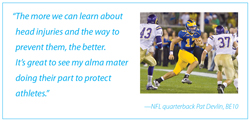
Finally, there is the major issue of what is known as “second impact syndrome,” which occurs when a person suffers a second concussion before symptoms from an earlier one have subsided.
“Identifying athletes who sustain a concussion is critical, as they need to be removed from competition and assessed before another blow to the head occurs,” says Steve Feldman, HS10, assistant athletic trainer for the Philadelphia Eagles. “Preventing a second impact before the brain has had time to heal from an initial injury is vital to prevent rapid brain swelling and potentially significant neurologic injury.”
The media frenzy around concussions has sent coaches, players and parents looking for solutions in the form of better protective equipment, modified playing techniques and rules, new diagnostic tools and treatment protocols and laws that regulate return to play after head injuries.
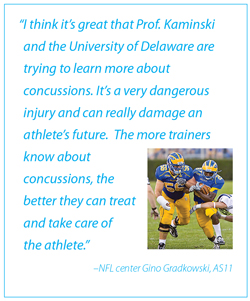
The answer to addressing the concussion crisis probably lies in a combination of all of these.
Engineering new solutions
A team at the Army Research Laboratory (ARL) led by Eric Wetzel, EG95, has developed a novel tether that attaches a football helmet to a player’s chest to prevent his head from snapping back and slamming into the ground in a tackle.
The device capitalizes on the properties of shear thickening fluids, whose stiffness changes under stress. At low speeds, they’re elastic and stretchable, but when hit with a violent force, they become rigid.
“The beauty of the tether is that it allows players to move their heads from side to side and up and down under normal playing conditions, but it tightens under impact, slowing the head down so that it hits the ground with less velocity,” Wetzel says.
The device is aimed specifically at preventing the type of head injury that occurs with a backwards fall.
The project was one of seven selected to receive $500,000 from the 2015 Head Health Challenge, a collaboration among the NFL, Under Armour, GE and the National Institute of Standards and Technology.
“Partnering with the NFL enables us to complete the loop,” says Wetzel. “We developed the technology here at ARL, we’ll test it on football players, and then we’ll bring the results back to the military.”
Wetzel credits his collaboration with Norm Wagner, the Robert L. Pigford Chaired Professor of Chemical and Biomolecular Engineering at UD, for at least part of his success in developing the RAT (rate-actuated tether) strap.
“Norm is a world-renowned expert in shear thickening fluids,” Wetzel says. “We are teaming with him [through STF Technologies, a spin-off company from his UD research] to make better materials for this application.”
Wagner has submitted a new proposal to Head Health Challenge to develop field-responsive nanocomposites in helmets.
“We’ve gotten good results in lab testing with these STF materials in terms of their capability to absorb energy,” he says. “We know that helmets can’t eliminate concussion, but we’re hopeful that the risk can be dramatically reduced for not only football players but also first responders, members of the military and youth athletes. We can’t solve all problems with our technology, but we can make people’s lives safer.”
What we don’t know
UD’s Kaminski says that we need the science to support decision making for athletes.
In 2011, he facilitated the passage of a concussion law that sets regulations for schools in the Delaware Interscholastic Athletic Association.
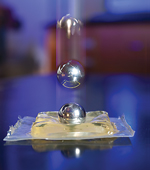
Concussion laws, which essentially promote a “when in doubt, sit it out” policy for interscholastic athletes, are now in effect in all 50 states and the District of Columbia. The first of these laws was passed in Washington in 2009 and named after Zachery Lystedt, a 13-year-old junior high football player who was left with permanent disabilities when he returned to play after a concussion and suffered a second injury in the same game.
Kaminski, who has been collecting data on ball heading in female soccer players for more than a decade, sees the laws as an essential first step in an ongoing process of education, training, data collection and policy-making to ensure that coaches, officials, players and parents work together to protect young athletes from the long-term effects of blows to the head.
But when it comes to making arbitrary decisions—for example, prohibiting heading in soccer players younger than 14—he’s reluctant to get on board.
“Why 14? Why not 12?,” he says. “Our goal is ultimately to have quantifiable data about outcomes, but it’s just too early for that. We’re really just starting to know what we don’t know.”
Article by Diane Kukich, AS73, 84M




